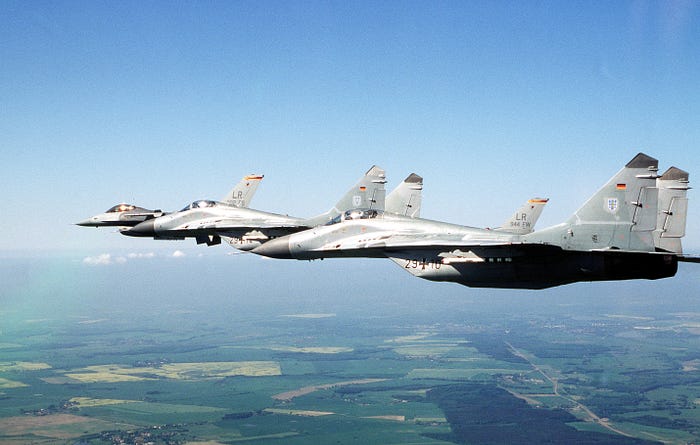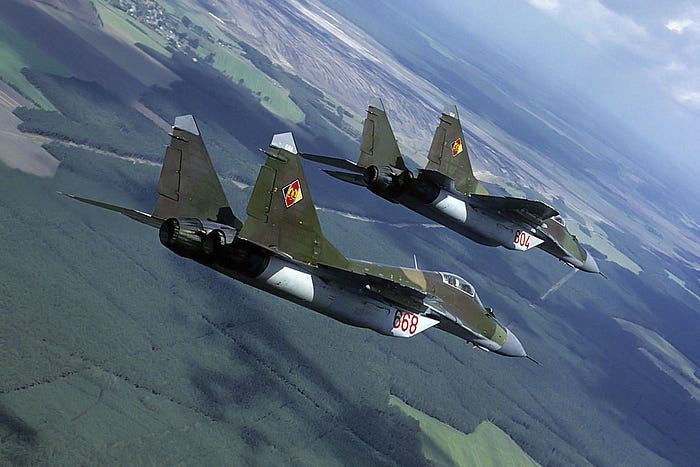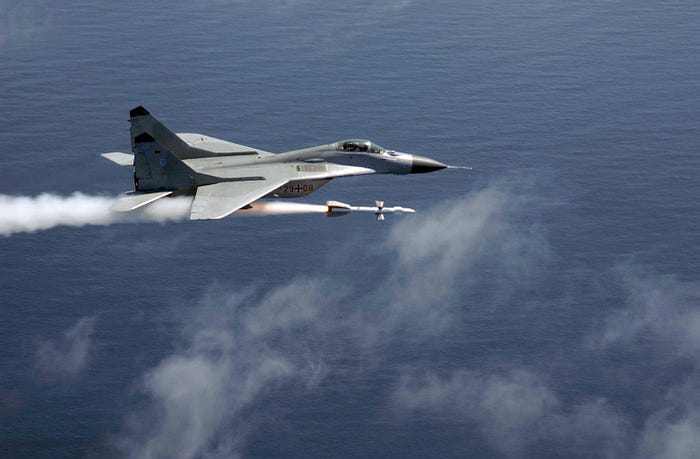A Rocket in the Sky: NATO’s First Impression of the MiG-29 Fulcrum

The Mikoyan-Gurevich MiG-29 (NATO codename: “Fulcrum”) is a twin-engine, all-weather fighter jet designed in the Soviet Union. Developed by the Mikoyan design bureau as an air superiority fighter during the 1970s, the Fulcrum, along with the larger Sukhoi Su-27 “Flanker”, was developed to counter new US fighters such as the McDonnell Douglas F-15 Eagle and the General Dynamics F-16 Fighting Falcon.

East Germany (DDR) bought 20 MiG-29A(9.12A) fighters and 4 MiG-29UB(9.51) two-seater combat-trainers just before the fall of the Berlin Wall, for the Luftstreitkräfte der NVA (East German Air Force). MiG-29A(9.12A) is an Eastern Block members-exclusive export version of the Soviet MiG-29A(9.12). Some of the MiG-29A(9.12A) will have some of their equipment dismantled and downgraded to non-Eastern Block export version MiG-29A(9.12B) standard. They entered service in 1988 and 1989. After the German reunification in October 1990, these Fulcrums were integrated into the Luftwaffe, made NATO-compatible, and stationed on Laage Fliegerhorst, with Luftwaffe Jagdgeschwader JG 73 “Steinhoff”.
Oberstleutnant Johannes Rudolf, German Tornado pilot and former L-39 Albatros pilot at MiGFlug, said about his experience in the Fulcrum:
“The MiG-29 is a rocket. It’s as simply as that”.
It soon turned out that claims of the Fulcrum being superior to Western fighter jets in some areas were right — for example, the Helmet Mounted Weapons Sight (HMS), a technology the US Air Force and Navy didn’t have operational until 2003 — or the dogfight capability and maneuverability, especially at slow speed. The Fulcrum demonstrated its ability impressively during joint US-German dissimilar air combat training (DACT). But we’ll have a closer look at that below.
In 2003, 22 of the Fulcrum — already upgraded to MiG-29G/GT standard — were sold to the Polish Air Force for a symbolic price of 1 EUR per Fulcrum, 14 of which were then taken into service with the 41. ELT (Eskadra Lotnictwa Taktycznego — Tactical Fighter Squadron) after being overhauled. Of the remaining two German Fulcrum, one had crashed after a pilot’s fault, and one (the 29+03) is on display at Laage-Rostock airport.

During service with the German Luftwaffe, Germany and its allies had the possibility to compare the Fulcrum like never before. Luftwaffe pilots who flew western jets before suddenly had the possibility to fly the state of the art multirole fighter aircraft of the Eastern Block. A lot of the experience was gained after the German reunification and the inheritance of the 24 East Germany Jagdgeschwader 3’s MiG-29s. That said, one must be aware that Germany inherited the export version of the earliest model MiG-29A, which was inferior to the Soviet MiG-29A(9.12), e.g. they are lacking the Lazlo data link and the SRO IFF transponders (on MiG-29A(9.12B) downgraded variant). And today’s latest MiG-29s are of course more advanced if not to say other aircraft, after several upgrades. A funny side note here: The NATO findings were an important source of improvement for Mikoyan OKB, to further improve the MiG-29.
Strengths
- Incredible turn rate. The manually controlled MiG-29 (28°/sec) even beats the fly by wire F-16 Block 50 (26°/sec).
- The Archer is able to target 45° off boresight.
- Superior in dogfights/close combat to US 4th generation fighter aircraft like McDonnell Douglas F-15 Eagle, General Dynamic F-16 Fighting Falcon, and McDonnell Douglas F/A-18 Hornet (as proved in dogfights with the Swiss Air Force among others).
- Helmet Mounted Sight.
- Ability to take off from unpaved runways or even highways
This led Johann Koeck, Oberstleutnant at German Luftwaffe, to the analysis:
“Inside ten nautical miles I’m hard to defeat, and with the IRST, helmet sight and ‘Archer’ (NATO designation for the R-73 missile) I can’t be beaten. Even against the latest Block 50 F-16s the MiG-29 is virtually invulnerable in the close-in scenario. On one occasion I remember the F-16s did score some kills eventually, but only after taking 18 ‘Archers’ (Just as we might seldom have got close-in if they used their AMRAAMs BVR!) They couldn’t believe it at the debrief, they got up and left the room!”.

Another quote by Test Pilot John Farley who got to fly the Fulcrum as one of the first Western pilots (lucky him!):
“Ever since the MiG-29 was first displayed in public at the Farnborough’88 airshow I’ve wanted to test fly the plane to see for myself how it handled. At Farnborough’90 I met Mikhail Waldenburg, chief designer for the Mikoyan Bureau, and Valery Menitsky, chief test pilot, to discuss the plane’s aerodynamic achievements. Valery then offered me the chance of a lifetime –
a flight in their two-seater to see how their plane flew. I wasn’t
disappointed, after years testing aircraft such as the Harrier for British Aerospace, the MiG-29 proved one of the most exhilarating flights I’ve ever had. When flying the MiG-29, note how the high thrust and low drag of this remarkable machine allows it to accelarate at low level during a 9g turn”.
The Fulcrum takeoff speed is 260 km/h to 280 km/h and it has an extremely low take-off distance. The Fulcrum can take off from a strip of only 240 m. The F-16 Fighting Falcon by comparison needs about twice that. Also, it is made to take off from unpaved runways. That is thanks to its rugged landing gear and protective air intake. They open and close automatically to prevent a foreign object from entering the intake. And even with closed air intakes, the Fulcrum is able to do an afterburner take-off. Soviet war planners expected to encounter damaged or under-prepared airstrips during a rapid armored advance. It is also comparatively easy to maintain and robust — made in a way that technician can do their job with gloves in Siberia for example. Regardless of the Design Bureau — Mikoyan/MiG is the most famous one, Sukhoi, Tupolev, Ilyushin, or Yakovlev are others — all Soviet fighter jets share this common ideology: Ease of maintenance, simplicity of the design, toughness, and the ability to operate from rough, unpaved airstrips of the shortest possible length.

Weaknesses
- Navigation system (before it got a GPS upgrade in MiG-29G/GT variant).
- Limited fuel capacity, thirsty engines, no in-flight refueling probe. Even with two underwing tanks, the MiG-29 is inferior when it comes to range. According to Koeck, the radius was only 100 — 150 nautical miles (185 — 278 km). Especially at high speed and low altitudes, the range is very limited.
- One VHF/UHF radio only.
- Inferior radar (limited autonomous operations, poor reliability, poor display, poor situational awareness, problems with targets flying in formation).
Let’s quote Oberstleutnant Köck again:
“The most obvious limitation of the MiG-29 was the aircraft’s limited internal fuel capacity of 3,500 kg (4,400 kg with a centerline tank). The MiG-29 had no air-to-air refueling capability, and its external tank was both speed and maneuver limited. If a mission started with 4,400 kg of fuel, start-up, taxy and take off took 400 kg, 1,000 kg were required for diversion to an alternate airfield 50 nm away, and 500 kg for the engagement, including one minute in afterburner, leaving only 2,500 kg of fuel. If we need 15 minutes on station at 420 kts that requires another 1000 kg, leaving 1,500 kg for transit. At FL 200 (20,000 ft) that gives us a radius of 150 nm, and at FL 100 (10,000 ft) we have a radius of only 100 nm”.
And about the Radar — Köck said:
“The MiG-29s radar had a poor display, giving poor situational awareness, and this was compounded by the cockpit ergonomics. The radar had reliability and lookdown/shootdown problems, hence its poor discrimination between targets flying in formation, and moreover it couldn’t lock onto the target in trail, only onto the lead”.
Mainly because of these two limitations, the MiG-29s role in the German Luftwaffe was restricted to only a few clearly defined roles. It was mainly used as adversary threat aircraft for dogfight training where it brought valuable insights into the training of not only German pilots. On top of that it was also used for point defense, and as wing (but never lead) in mixed Fighter Operations.
Source:
- MiGFlug
- NATO Spreadsheets
